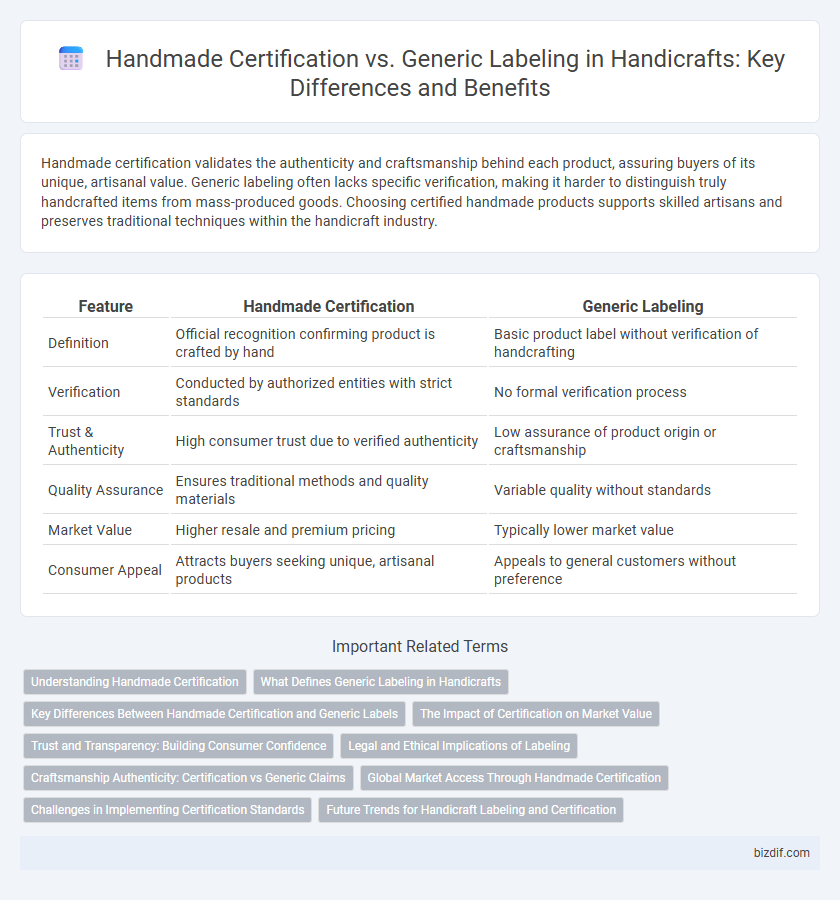Handmade certification validates the authenticity and craftsmanship behind each product, assuring buyers of its unique, artisanal value. Generic labeling often lacks specific verification, making it harder to distinguish truly handcrafted items from mass-produced goods. Choosing certified handmade products supports skilled artisans and preserves traditional techniques within the handicraft industry.
Table of Comparison
| Feature | Handmade Certification | Generic Labeling |
|---|---|---|
| Definition | Official recognition confirming product is crafted by hand | Basic product label without verification of handcrafting |
| Verification | Conducted by authorized entities with strict standards | No formal verification process |
| Trust & Authenticity | High consumer trust due to verified authenticity | Low assurance of product origin or craftsmanship |
| Quality Assurance | Ensures traditional methods and quality materials | Variable quality without standards |
| Market Value | Higher resale and premium pricing | Typically lower market value |
| Consumer Appeal | Attracts buyers seeking unique, artisanal products | Appeals to general customers without preference |
Understanding Handmade Certification
Handmade certification ensures products meet strict criteria confirming authentic artisanal craftsmanship, offering consumers verified quality and legitimacy compared to generic labeling. This certification often involves scrutiny of production methods, material sourcing, and artisan involvement, distinguishing true handmade goods from mass-produced items. Understanding handmade certification empowers buyers to support ethical practices and preserves cultural heritage through genuine craftsmanship.
What Defines Generic Labeling in Handicrafts
Generic labeling in handicrafts refers to the use of non-specific terms that do not provide information about the product's origin, authenticity, or the artisan's involvement, often focusing solely on the item's function or material. This labeling lacks the verification of craftsmanship techniques or cultural significance, making it difficult for consumers to distinguish between mass-produced and genuinely handmade items. Unlike handmade certification, generic labels do not guarantee quality standards or ethical production practices associated with traditional handicraft methods.
Key Differences Between Handmade Certification and Generic Labels
Handmade certification verifies the authenticity and craftsmanship of products, ensuring they meet specific traditional or artisanal standards, unlike generic labels that often lack detailed origin or quality assurance. Certified handmade goods typically involve rigorous evaluation of materials, techniques, and artisan involvement, providing consumers with trusted provenance and uniqueness. Generic labels, by contrast, generally serve as broad marketing tags without guaranteeing handcrafted quality or adherence to cultural craftsmanship criteria.
The Impact of Certification on Market Value
Handmade certification significantly enhances the market value of handicrafts by assuring authenticity, quality, and artisanal origin, distinguishing them from generic labeled products. Certified handmade items attract discerning consumers willing to pay premium prices due to proven craftsmanship, ethical sourcing, and cultural heritage preservation. Market data indicates that certified products can command up to 30% higher prices and achieve greater brand loyalty compared to non-certified handicrafts.
Trust and Transparency: Building Consumer Confidence
Handmade certification provides verifiable proof of authenticity, fostering higher consumer trust compared to generic labeling, which often lacks detailed product origin information. This certification ensures transparency by validating the artisan's skill, materials used, and ethical production methods, which generic labels typically do not disclose. Enhanced transparency builds stronger consumer confidence, encouraging informed purchasing decisions rooted in genuine craftsmanship.
Legal and Ethical Implications of Labeling
Handmade certification provides legally regulated standards ensuring authenticity, which protects both artisans and consumers from misleading claims. Generic labeling often lacks transparency, potentially violating consumer protection laws and ethical standards by obscuring product origins. Ensuring accurate labeling upholds intellectual property rights and supports fair trade practices within the handicraft industry.
Craftsmanship Authenticity: Certification vs Generic Claims
Handmade certification provides verifiable proof of craftsmanship authenticity by ensuring artisans meet specific quality and traditional standards, unlike generic labeling which often lacks transparency and can mislead consumers. Certification highlights skilled techniques and cultural heritage, enhancing trust and value in handcrafted products. Consumers seeking genuine artisanal work rely on these certifications to distinguish true craftsmanship from mass-produced imitations.
Global Market Access Through Handmade Certification
Handmade certification enhances global market access by validating authenticity and quality, distinguishing products from generic labeling that lacks standardized verification. Certified handmade items meet recognized international standards, increasing consumer trust and opening opportunities in premium markets worldwide. This certification supports artisans by providing a competitive edge and facilitating export through compliance with global trade regulations.
Challenges in Implementing Certification Standards
Implementing Handmade Certification standards faces challenges such as inconsistent definitions of "handmade" that vary across regions, complicating standardization and enforcement. The high costs and time-consuming processes required for certification deter many artisans, especially in developing markets with limited resources. Additionally, monitoring and verifying the authenticity of handmade claims demand rigorous inspection systems, which can be difficult to maintain at scale.
Future Trends for Handicraft Labeling and Certification
Future trends in handicraft labeling and certification emphasize enhanced transparency through blockchain technology, ensuring authenticity and traceability of handmade products. Increasing consumer demand for ethical sourcing and sustainable craftsmanship drives the adoption of specialized handmade certifications over generic labeling. Digital platforms will integrate advanced verification methods, fostering trust and supporting artisans in global markets.
Handmade Certification vs Generic Labeling Infographic

 bizdif.com
bizdif.com